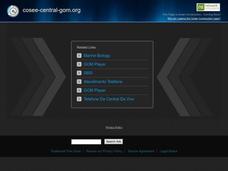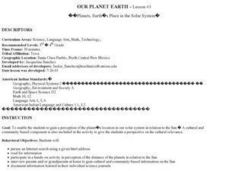Curated OER
The Greenhouse Effect
Students complete a group experiment which simulates the greenhouse effect as well as compare the climate on Earth to the climate on Venus following a class discussion on the greenhouse effect.
Curated OER
Our Planet, Earth-Internet Research
Students review the procedure for conducting Internet research and then research the earth--its physical characteristics, components, and cultural folklore regarding the planet. They compile the information they find into a report in...
Curated OER
Earth's Place in the Solar System
Students study and discuss the planets. They create a visual representation of the layout of the solar system and color it. They also write an informative/narrative summary report on the cultural relevance of the Sun.
Curated OER
TE Activity: Nidy-Gridy
Middle schoolers make a grid and coordinate system map of their classroom as they investigate why it is important to have a common map making system. They look at how landmarks are used for navigating an area.
Curated OER
Earth
First graders define what a planet is and study the planet earth. They examine the effects of the sun on the earth and make a model.
Curated OER
Wow, Saturn Is Much Bigger Than Earth!
Students compare and contrast the sizes of Earth and Saturn. They create scale illustrations of each planet and label them. They share their models with the class.
Curated OER
Scale Model of the Earth
Students work together to create a model of the Earth. They label and identify each layer and describing its properties. They discover how engineers use models to test different concepts.
Curated OER
Earth/Globe (poles & equator)
First graders create his/her own paper mache earth and label the poles and equator. The land masses can be added and labeling of specific bodies of water. The paper mache earth can then be used to discuss the sun, moon, and the earth and...
Curated OER
How Can a Spacecraft Always Face the Sun?
Young scholars determine the correct orbital path for a satellite that collects data about the sun so that its view of the sun never be obstructed by the Earth.
Curated OER
How Far Away is SOHO?
Students create a scale model of the Earth and the sun that demonstrates where the SOHO satellite is in relation to the Earth.
Curated OER
May Earth be Revolving around the Sun?
Ninth graders explore how Aristarchus used the position of the half-full Moon to estimate the distance to the Sun, and how he made a great error, but still figured out that the Sun is much larger than Earth.
Curated OER
Changing Ways
Third graders examine hard boiled eggs as possible models for the earth's layers.
Curated OER
Spaceship Earth
Students consider the earth and its problems as a system. They examine the fragility of that system when population, pollution, 1st world verse 3rd world, terrorism, etc., are considered as interactive parts of a spaceship earth.
Curated OER
The Planet Earth
Learners explore the planet Earth, outer space, and Earth's axis. They demonstrate reading comprehension skills, including literal meaning, inference and critical analysis.
Curated OER
The Differences Between the Earth and the Moon
Fifth graders identify the physical characteristics of the Earth and compare them to the physical characteristics of the moon. They produce a chart with Microsoft Excel to record the physical characteristics of both the Earth and the moon.
Curated OER
A Thin Slice of Soil
Students examine the importance of soil in the production of what we eat and wear, and analyze the percentages of the earth used for food production. They create their own Pyramids of Life, and construct Dirt Babies out of hosiery, dirt...
ClassFlow
Class Flow: The Earth's History
[Free Registration/Login Required] This flipchart is a lesson on the geologic history of the Earth. It covers the four main eras of the geologic time scale: Precambrian, Paleozoic, Mesozoic, and Cenozoic. Characteristics of each era are...
Curated OER
Science Kids: Science Images: The Earth
Looking at the planet earth from space. The continent of Africa is visible behind the cloud cover as well as a large quantity of water in the blue oceans that make up a majority of the globes surface.




















